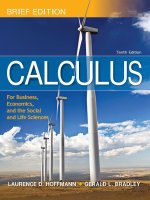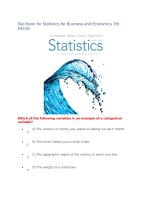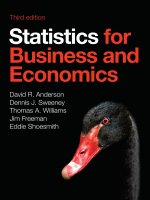Statistics for business economics 7th by paul newbold chapter 07
Bạn đang xem bản rút gọn của tài liệu. Xem và tải ngay bản đầy đủ của tài liệu tại đây (322.42 KB, 62 trang )
Statistics for
Business and Economics
7th Edition
Chapter 7
Estimation: Single Population
Copyright © 2010 Pearson Education, Inc. Publishing as Prentice Hall
Ch. 7-1
Chapter Goals
After completing this chapter, you should be able to:
Distinguish between a point estimate and a
confidence interval estimate
Construct and interpret a confidence interval estimate
for a single population mean using both the Z and t
distributions
Form and interpret a confidence interval estimate for
a single population proportion
Create confidence interval estimates for the variance
of a normal population
Copyright © 2010 Pearson Education, Inc. Publishing as Prentice Hall
Ch. 7-2
Confidence Intervals
Contents of this chapter:
Confidence Intervals for the Population
Mean, μ
when Population Variance σ2 is Known
when Population Variance σ2 is Unknown
Confidence Intervals for the Population
Proportion, (large samples)
pˆ
Confidence interval estimates for the
variance of a normal population
Copyright © 2010 Pearson Education, Inc. Publishing as Prentice Hall
Ch. 7-3
7.1
Definitions
An estimator of a population parameter is
a random variable that depends on sample information . . .
whose value provides an approximation to this unknown parameter
A specific value of that random variable is called an
estimate
Copyright © 2010 Pearson Education, Inc. Publishing as Prentice Hall
Ch. 7-4
Point and Interval Estimates
A point estimate is a single number,
a confidence interval provides additional
information about variability
Lower
Confidence
Limit
Point Estimate
Upper
Confidence
Limit
Width of
confidence interval
Copyright © 2010 Pearson Education, Inc. Publishing as Prentice Hall
Ch. 7-5
Point Estimates
We can estimate a
Population Parameter …
with a Sample
Statistic
(a Point Estimate)
Mean
μ
x
Proportion
P
pˆ
Copyright © 2010 Pearson Education, Inc. Publishing as Prentice Hall
Ch. 7-6
Unbiasedness
ˆis said to be an unbiased
A point estimator θ
estimator of the parameter θ if the expected
value, or mean, of the sampling distribution of
is θ,
ˆ
θ
E(θˆ ) = θ
Examples:
The sample mean
is an unbiased estimator of μ
The sample variance
x s2 is an unbiased estimator of σ2
The sample proportion
is an unbiased estimator of P
pˆ
Copyright © 2010 Pearson Education, Inc. Publishing as Prentice Hall
Ch. 7-7
Unbiasedness
(continued)
θˆ 1 is an unbiased estimator,
θˆ 1
ˆ biased:
is
θ
2
θˆ 2
θ
Copyright © 2010 Pearson Education, Inc. Publishing as Prentice Hall
θˆ
Ch. 7-8
Bias
Let
ˆbe an estimator of θ
θ
The bias in θ
ˆis defined as the difference between
its mean and θ
Bias(θˆ ) = E(θˆ ) − θ
The bias of an unbiased estimator is 0
Copyright © 2010 Pearson Education, Inc. Publishing as Prentice Hall
Ch. 7-9
Most Efficient Estimator
Suppose there are several unbiased estimators of θ
The most efficient estimator or the minimum variance
unbiased estimator of θ is the unbiased estimator with
the smallest variance
Let θˆ 1 and θˆ 2 be two unbiased estimators of θ, based
on the same number of sample observations. Then,
ˆ is said to be more efficient than
if
θ
θˆ
Var( θˆ ) < Var( θˆ )
1
The relative efficiency of
2
with respect to
θˆ 1
is the ratio of their variances:
1
2
θˆ 2
Var( θˆ 2 )
Relative Efficiency =
Var( θˆ )
1
Copyright © 2010 Pearson Education, Inc. Publishing as Prentice Hall
Ch. 7-10
7.2
Confidence Intervals
How much uncertainty is associated with a point
estimate of a population parameter?
An interval estimate provides more information
about a population characteristic than does a
point estimate
Such interval estimates are called confidence
intervals
Copyright © 2010 Pearson Education, Inc. Publishing as Prentice Hall
Ch. 7-11
Confidence Interval Estimate
An interval gives a range of values:
Takes into consideration variation in sample
statistics from sample to sample
Based on observation from 1 sample
Gives information about closeness to
unknown population parameters
Stated in terms of level of confidence
Can never be 100% confident
Copyright © 2010 Pearson Education, Inc. Publishing as Prentice Hall
Ch. 7-12
Confidence Interval and
Confidence Level
If P(a < θ < b) = 1 - α then the interval from a to b
is called a 100(1 - α)% confidence interval of θ.
The quantity (1 - α) is called the confidence level of
the interval (α between 0 and 1)
In repeated samples of the population, the true value of the parameter θ would be contained in 100(1 - α)
% of intervals calculated this way.
The confidence interval calculated in this manner is written as a < θ < b with 100(1 - α)% confidence
Copyright © 2010 Pearson Education, Inc. Publishing as Prentice Hall
Ch. 7-13
Estimation Process
Random Sample
Population
(mean, μ, is
unknown)
Mean
X = 50
I am 95%
confident that
μ is between
40 & 60.
Sample
Copyright © 2010 Pearson Education, Inc. Publishing as Prentice Hall
Ch. 7-14
Confidence Level, (1-α)
(continued)
Suppose confidence level = 95%
Also written (1 - α) = 0.95
A relative frequency interpretation:
From repeated samples, 95% of all the confidence intervals that can be constructed will contain
the unknown true parameter
A specific interval either will contain or will not
contain the true parameter
No probability involved in a specific interval
Copyright © 2010 Pearson Education, Inc. Publishing as Prentice Hall
Ch. 7-15
General Formula
The general formula for all confidence
intervals is:
Point Estimate ± (Reliability Factor)(Standard Error)
The value of the reliability factor depends
on the desired level of confidence
Copyright © 2010 Pearson Education, Inc. Publishing as Prentice Hall
Ch. 7-16
Confidence Intervals
Confidence
Intervals
Population
Mean
σ2 Known
Population
Proportion
Population
Variance
σ2 Unknown
Copyright © 2010 Pearson Education, Inc. Publishing as Prentice Hall
Ch. 7-17
Confidence Interval for μ
(σ2 Known)
7.2
Assumptions
Population variance σ2 is known
Population is normally distributed
If population is not normal, use large sample
Confidence interval estimate:
σ
σ
x − z the normal
+ zfor
α/2 a probability of
(where z isα/2
n
n
α/2 in each tail)
α/2
Copyright © 2010 Pearson Education, Inc. Publishing as Prentice Hall
Ch. 7-18
Margin of Error
The confidence interval,
x − z α/2
σ
σ
< μ < x + z α/2
n
n
Can also be written as x ± ME
where ME is called the margin of error
ME = z α/2
σ
n
The interval width, w, is equal to twice the margin of
error
Copyright © 2010 Pearson Education, Inc. Publishing as Prentice Hall
Ch. 7-19
Reducing the Margin of Error
ME = z α/2
σ
n
The margin of error can be reduced if
the population standard deviation can be reduced
(σ↓)
The sample size is increased (n↑)
The confidence level is decreased, (1 – α) ↓
Copyright © 2010 Pearson Education, Inc. Publishing as Prentice Hall
Ch. 7-20
Finding the Reliability Factor, zα/2
Consider a 95% confidence interval:
1 − α = .95
α
= .025
2
Z units:
X units:
α
= .025
2
z = -1.96
Lower
Confidence
Limit
0
Point Estimate
z = 1.96
Upper
Confidence
Limit
Find z.025 = ± 1.96 from the standard normal distribution table
Copyright © 2010 Pearson Education, Inc. Publishing as Prentice Hall
Ch. 7-21
Common Levels of Confidence
Commonly used confidence levels are 90%, 95%,
and 99%
Confidence
Level
Confidence
Coefficient,
Zα /2 value
.80
.90
.95
.98
.99
.998
.999
1.28
1.645
1.96
2.33
2.58
3.08
3.27
1− α
80%
90%
95%
98%
99%
99.8%
99.9%
Copyright © 2010 Pearson Education, Inc. Publishing as Prentice Hall
Ch. 7-22
Intervals and Level of Confidence
Sampling Distribution of the Mean
1− α
α/2
Intervals
extend from
α/2
x
μx = μ
x1
σ
LCL = x − z
n
x2
to
σ
UCL = x + z
n
Confidence Intervals
Copyright © 2010 Pearson Education, Inc. Publishing as Prentice Hall
100(1-α)%
of intervals
constructed
contain μ;
100(α)% do
not.
Ch. 7-23
Example
A sample of 11 circuits from a large normal
population has a mean resistance of 2.20 ohms.
We know from past testing that the population
standard deviation is 0.35 ohms.
Determine a 95% confidence interval for the
true mean resistance of the population.
Copyright © 2010 Pearson Education, Inc. Publishing as Prentice Hall
Ch. 7-24
Example
(continued)
A sample of 11 circuits from a large normal
population has a mean resistance of 2.20 ohms.
We know from past testing that the population
standard deviation is .35 ohms.
Solution:
σ
x± z
n
= 2.20 ± 1.96 (.35/ 11 )
= 2.20 ± .2068
1.9932 < μ < 2.4068
Copyright © 2010 Pearson Education, Inc. Publishing as Prentice Hall
Ch. 7-25









